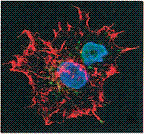Biochemistry, Department of

Gautam Sarath Publications
ORCID IDs
Document Type
Article
Date of this Version
1995
Abstract
Steady-state kinetic analyses were performed on the non-phosphorylated, in vitro phosphorylated and phosphorylation-site mutant (Ser8→Asp) forms of purified recombinant sorghum C4 phosphoenolpyruvate (P-pyruvate) carboxylase (EC 4.1.1.3 1) containing an intact N-terminus. Significant differences in certain kinetic parameters were observed between these three enzyme forms when activity was assayed at a suboptimal but near-physiological pH (7.3), but not at optimal pH (8.0). Most notably, at pH 7.3 the apparent Ki/ for the negative allosteric effector l-malate was 0.17 mM, 1.2 mM and 0.45 mM while the apparent Ka for the positive allosteric effector glucose 6-phosphate (Glc6P) at 1mM P-pyruvate was 1.3 mM, 0.28 mM and 0.45 mM for the dephosphorylated, phosphorylated and mutant forms of the enzyme, respectively. These and related kinetic analyses at pH 7.3 show that phosphorylation of C4 P-pyruvate carboxylase near its N-terminus has a relatively minor effect on V and Km (total P-pyruvate) but has a dramatic effect on the extent of activation by Glc6P, type of inhibition by l-malate and, most especially, Ka (Glc6P) and Kiv (l-malate). Thus, regulatory phosphorylation profoundly influences the interactive allosteric properties of this cytosolic C4-photosynthesis enzyme.


Comments
Published in European Journal of Biochemistry 228 (1995), pp. 92–95. Copyright © 1995 FEBS. Used by permission.